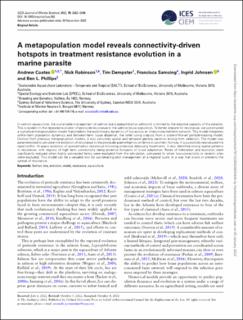| dc.contributor.author | Coates, Andrew | |
| dc.contributor.author | Robinson, Nicholas Andrew | |
| dc.contributor.author | Dempster, Tim | |
| dc.contributor.author | Samsing, Francisca | |
| dc.contributor.author | Johnsen, Ingrid Askeland | |
| dc.contributor.author | Phillips, Ben L. | |
| dc.date.accessioned | 2023-01-11T10:31:31Z | |
| dc.date.available | 2023-01-11T10:31:31Z | |
| dc.date.created | 2022-12-22T10:49:22Z | |
| dc.date.issued | 2022 | |
| dc.identifier.citation | ICES Journal of Marine Science. 2022, 79 (10), 2682-2696. | |
| dc.identifier.issn | 1054-3139 | |
| dc.identifier.uri | https://hdl.handle.net/11250/3042651 | |
| dc.description.abstract | In salmon aquaculture, the sustainable management of salmon lice (Lepeophtheirus salmonis) is limited by the adaptive capacity of the parasite. This is evident in the repeated evolution of pesticide resistance in the salmon louse population. To better prepare for resistance, we constructed a numerical metapopulation model that predicts the evolutionary dynamics of lice across an interconnected farm network. This model integrates within-farm population dynamics and between-farm louse dispersal, the latter using outputs from a state-of-the-art particle-tracking model. Distinct from previous metapopulation models, it also simulates spatial and temporal genetic variation arising from selection. The model was parameterized to simulate the evolution of resistance to the pesticide azamethiphos on farms in southern Norway. It successfully reproduced the rapid (within 10 years) evolution of azamethiphos resistance following extensive delousing treatments. It also identified strong spatial patterns in resistance, with regions of high farm connectivity being potential hotspots of louse adaptation. Rates of infestation and evolution were significantly reduced when highly connected farms were excluded from the simulation, compared to when low-connectivity or random sites were excluded. This model can be a valuable tool for coordinating pest management at a regional scale, in a way that slows or prevents the spread of resistance. | |
| dc.description.abstract | A metapopulation model reveals connectivity-driven hotspots in treatment resistance evolution in a marine parasite | |
| dc.language.iso | eng | |
| dc.title | A metapopulation model reveals connectivity-driven hotspots in treatment resistance evolution in a marine parasite | |
| dc.title.alternative | A metapopulation model reveals connectivity-driven hotspots in treatment resistance evolution in a marine parasite | |
| dc.type | Peer reviewed | |
| dc.type | Journal article | |
| dc.description.version | publishedVersion | |
| dc.source.pagenumber | 2682-2696 | |
| dc.source.volume | 79 | |
| dc.source.journal | ICES Journal of Marine Science | |
| dc.source.issue | 10 | |
| dc.identifier.doi | 10.1093/icesjms/fsac202 | |
| dc.identifier.cristin | 2096863 | |
| dc.relation.project | Fiskeri- og havbruksnæringens forskningsfinansiering: 901631 | |
| dc.relation.project | Nofima AS: 13152 | |
| cristin.ispublished | true | |
| cristin.fulltext | original | |
| cristin.qualitycode | 2 | |
